Heat Transfer Estimation in Flow Boiling of R134a within Microfin Tubes: Development of Explainable Machine Learning-Based Pipelines
Abstract
1. Introduction
1.1. Artificial Intelligence and Machine Learning Models
1.2. The Contributions of The Present Study
- Utilizing the experimental dataset on R134a flow under diverse operating conditions undergoing the evaporation process within microfin tubes.
- Gathering widely adopted empirical correlations for heat transfer estimation of two-phase flows from the literature and applying them to the available experimental dataset to obtain their performance.
- Developing various ML pipelines utilizing a range of ML algorithms including extra trees regressor and assessing their performance.
- Providing a feature selection procedure to identify the most promising set of features by employing various combinations of features systematically in the prediction of the target and assessing their performance, leading to a notable reduction in the number of features, reducing model complexity, and facilitating physical interpretation of the results.
- Utilizing a genetic algorithm-based pipeline optimization tool, with a focus on identifying the most suitable algorithm from a broad array of machine learning solutions, refining the tuning parameters, and their sequence in the pipeline.
- Employing an in-house algorithm (forward feature combination), taking the optimal pipeline and the selected features as inputs, and demonstrating the contribution of each feature to the overall achieved accuracy, providing a trade-off between the complexity of the model and the obtained accuracy.
2. Experimental Activity and the Employed Dataset
2.1. The Laboratory Setup
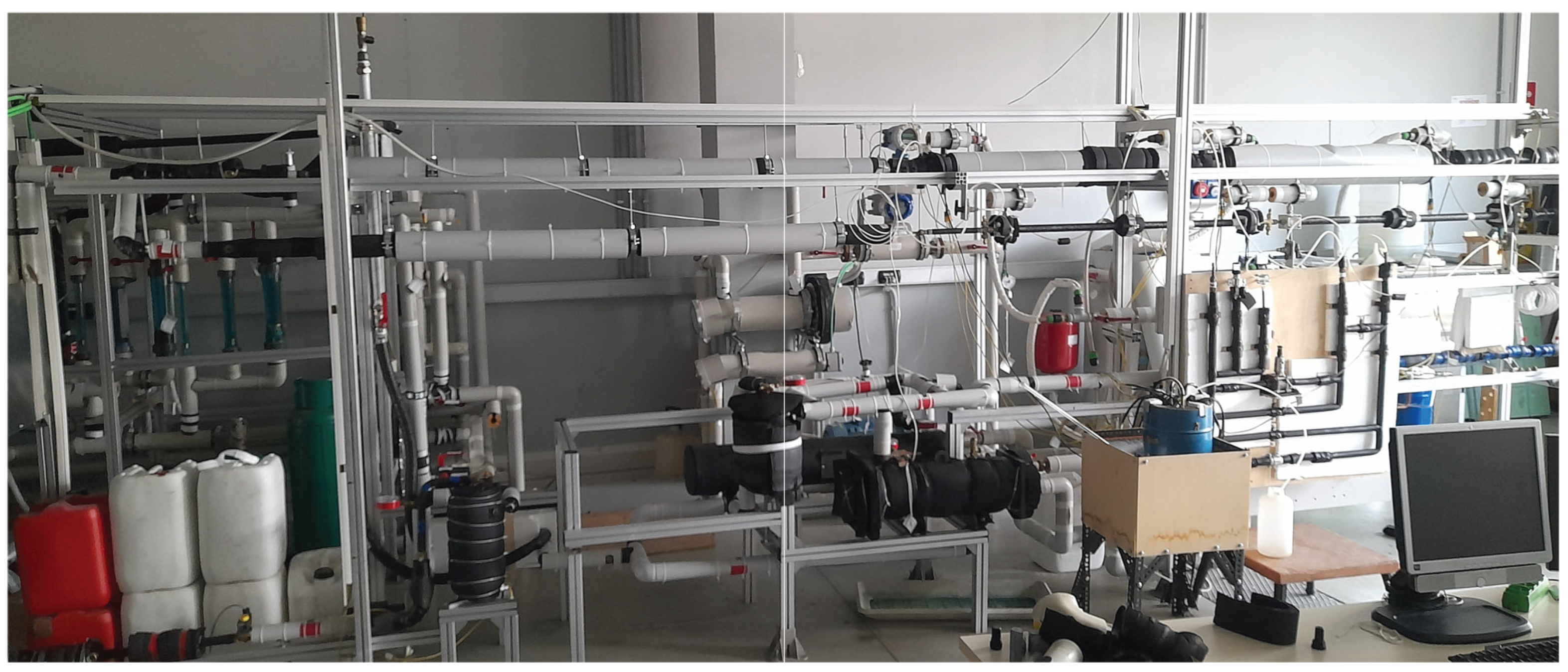

2.2. The Test Section
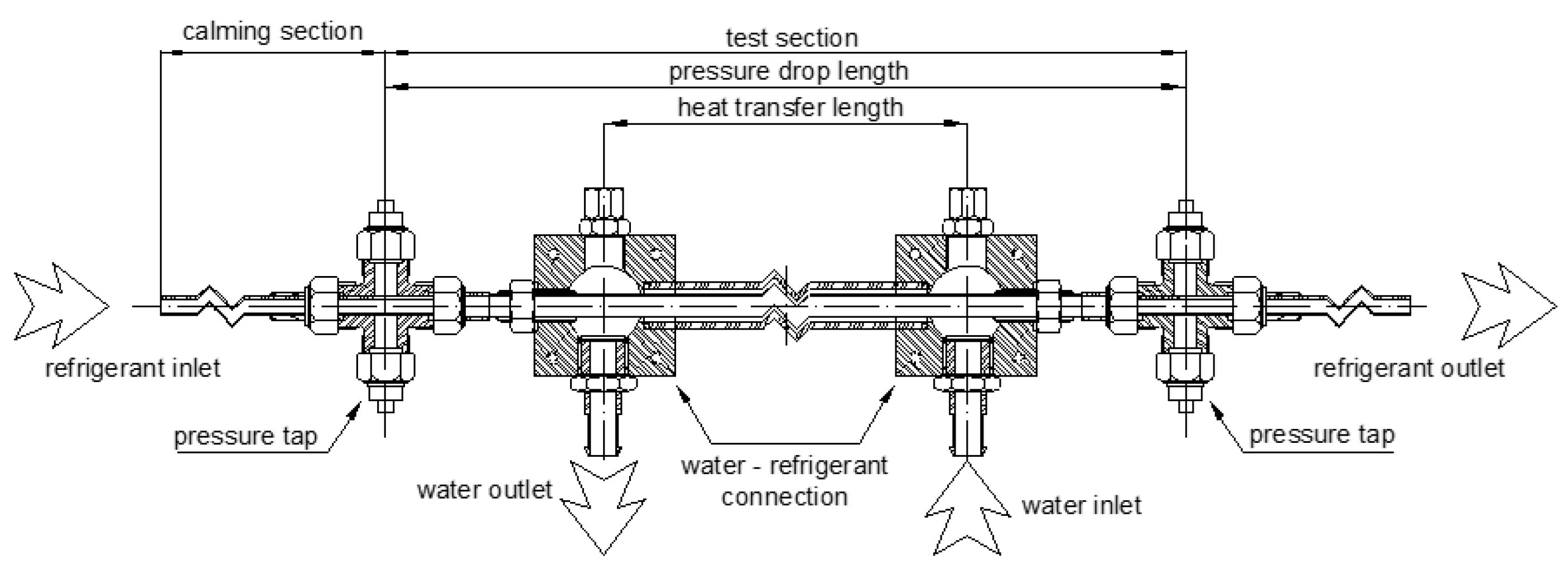
Temperature Measurement
2.3. Experiments
3. Dimensionless Numbers of Phase-Changing Flow
| Dimensionless Number | Formulation | No. |
|---|---|---|
| Nusselt number | (2) | |
| Reynolds number | (3) | |
| Weber number | (4) | |
| Froude number | (5) | |
| Prandtl number | (6) | |
| Boiling number | (7) | |
| Jakob number | (8) | |
| Bond number | (9) | |
| Convection number | (10) | |
| Kapitza number | (11) | |
| Galileo number | (12) | |
| Suratman number | (13) | |
| Lockhart–Martinelli parameter [39] | (14) | |
| Dimensionless vapor velocity [40] | (15) | |
| Reduced pressure | (16) |
4. Empirical and Semi-Empirical Correlations
5. Methodology and Implemented Pipelines
5.1. Feature Selection
5.2. Pipeline Optimization
5.3. Performance Evaluation
5.4. Machine Learning Models
5.4.1. Ridge Regression
5.4.2. Elastic Net
5.4.3. Random Forest
5.4.4. Extra Trees Regressor
5.4.5. Feature Processors
- PolynomialFeatures: A feature matrix is constructed that encompasses all polynomial terms of the input features up to a given degree. For example, with a two-dimensional input [a, b], the polynomial features up to degree 2 would include [1, a, b, a2, ab, b2] [59].
- MaxAbsScaler: This tool scales each feature so that its maximum absolute value is 1 while preserving the original data distribution by not shifting or centering the values [54].
- RobustScaler: It operates by normalizing data according to the range between the quantiles, excluding the median from the scaling process. Each feature is scaled and centered independently by calculating relevant statistics from the training data. These statistics (the median and interquartile range) are then stored and applied to transform any new data accordingly.
5.5. Contribution of Each Feature to Optimal Accuracy
6. Results and Discussion
6.1. Accuracy of Physical Models Available in the Literature
6.2. Initial Pipeline and Feature Selection Results
6.3. Machine Learning Pipeline Optimization
6.4. Forward Feature Combination
7. Conclusions
- The feature selection algorithm managed to select 6 features (, , , , , ) among the pool of 21 features. The physical interpretation of the selected features confirmed their higher order of relevance to the target of the predictions.
- The optimized pipeline improved the prediction accuracy and obtained an MARD value of 7.71% on the validation set and an MARD value of 8.84% on the test set, while the most promising empirical model (Rollmann and Spindler’s model Equation (19)) achieved MARD values of 23.1% and 19.7%, respectively on the validation and the test sets. Moreover, the proposed optimal pipeline accompanied by the employed dataset will be made publicly available.
- In future works, the employed dataset should be extended, incorporating data obtained from multiple experimental facilities, which will permit training the algorithms using the data belonging to a test rig while utilizing datasets obtained from other experimental facilities as the test set [30,60,61,62].
- Finally, it should be noted the main contribution of this study, beyond proposing an algorithm resulting in an elevated performance (even if only over the considered dataset), is identifying the most promising set of dimensionless features, which facilitates the corresponding physical interpretation.
Author Contributions
Funding
Data Availability Statement
Conflicts of Interest
References
- Thome, J.R.; Favrat, D.; Kattan, N. Evaporation in Microfin Tubes: A Generalized Prediction Model; Technical Report; Taylor & Francis: Oxfordshire, UK, 1999. [Google Scholar]
- Cavallini, A.; Del Col, D.; Doretti, L.; Longo, G.A.; Rossetto, L. Refrigerant vaporization inside enhanced tubes: A heat transfer model. Heat Technol. 1999, 17, 29–36. [Google Scholar]
- Yun, R.; Kim, Y.; Seo, K.; Young Kim, H. A generalized correlation for evaporation heat transfer of refrigerants in micro-fin tubes. Int. J. Heat Mass Transf. 2002, 45, 2003–2010. [Google Scholar] [CrossRef]
- Chamra, L.M.; Mago, P.J. Modelling of evaporation heat transfer of pure refrigerants and refrigerant mixtures in microfin tubes. Proc. Inst. Mech.Eng. Part C J. Mech. Eng. Sci. 2007, 221, 443–454. [Google Scholar] [CrossRef]
- Rollmann, P.; Spindler, K. New models for heat transfer and pressure drop during flow boiling of R407C and R410A in a horizontal microfin tube. Int. J. Therm. Sci. 2016, 103, 57–66. [Google Scholar] [CrossRef]
- Han, X.H.; Fang, Y.B.; Wu, M.; Qiao, X.G.; Chen, G.M. Study on flow boiling heat transfer characteristics of R161/oil mixture inside horizontal micro-fin tube. Int. J. Heat Mass Transf. 2017, 104, 276–287. [Google Scholar] [CrossRef]
- Mehendale, S. A new heat transfer coefficient correlation for pure refrigerants and near-azeotropic refrigerant mixtures flow boiling within horizontal microfin tubes. Int. J. Refrig. 2018, 86, 292–311. [Google Scholar] [CrossRef]
- Dai, B.; Wu, T.; Liu, S.; Qi, H.; Zhang, P.; Wang, D.; Wang, X. Flow boiling heat transfer characteristics of zeotropic mixture CO2/R152a with large temperature glide in a 2 mm horizontal tube. Int. J. Heat Mass Transf. 2024, 218, 124779. [Google Scholar] [CrossRef]
- Mikielewicz, D.; Mikielewicz, J.; Tesmar, J. Improved semi-empirical method for determination of heat transfer coefficient in flow boiling in conventional and small diameter tubes. Int. J. Heat Mass Transf. 2007, 50, 3949–3956. [Google Scholar] [CrossRef]
- Pysz, M.; Mikielewicz, D. Flow boiling of R1233zd (E) in a 3 mm vertical tube at moderate and high reduced pressures. Exp. Therm. Fluid Sci. 2023, 147, 110964. [Google Scholar] [CrossRef]
- Hastie, T.; Tibshirani, R.; Friedman, J. Introduction. In The Elements of Statistical Learning: Data Mining, Inference, and Prediction; Springer: New York, NY, USA, 2009; pp. 1–8. [Google Scholar] [CrossRef]
- Abbassi, A.; Bahar, L. Application of neural network for the modeling and control of evaporative condenser cooling load. Appl. Therm. Eng. 2005, 25, 3176–3186. [Google Scholar] [CrossRef]
- Lecoeuche, S.; Lalot, S.; Desmet, B. Modelling a non-stationary single tube heat exchanger using multiple coupled local neural networks. Int. Commun. Heat Mass Transf. 2005, 32, 913–922. [Google Scholar] [CrossRef]
- Díaz, G.; Sen, M.; Yang, K.; McClain, R.L. Dynamic prediction and control of heat exchangers using artificial neural networks. Int. J. Heat Mass Transf. 2001, 44, 1671–1679. [Google Scholar] [CrossRef]
- Díaz, G.; Sen, M.; Yang, K.T.; McClain, R.L. Simulation of Heat Exchanger Performance by Artificial Neural Networks. HVAC&R Res. 1999, 5, 195–208. [Google Scholar] [CrossRef]
- Bar, N.; Bandyopadhyay, T.K.; Biswas, M.N.; Das, S.K. Prediction of pressure drop using artificial neural network for non-Newtonian liquid flow through piping components. J. Pet. Sci. Eng. 2010, 71, 187–194. [Google Scholar] [CrossRef]
- Pacheco-Vega, A.; Sen, M.; McClain, R.L. Analysis of fin-tube evaporator performance with limited experimental data using artificial neural networks. In Proceedings of the ASME 2000 International Mechanical Engineering Congress and Exposition, Orlando, FL, USA, 5–10 November 2000; Volume 366, pp. 95–101. [Google Scholar]
- Najafi, B.; Ardam, K.; Hanušovský, A.; Rinaldi, F.; Colombo, L.P.M. Machine learning based models for pressure drop estimation of two-phase adiabatic air-water flow in micro-finned tubes: Determination of the most promising dimensionless feature set. Chem. Eng. Res. Des. 2021, 167, 252–267. [Google Scholar] [CrossRef]
- Ardam, K.; Najafi, B.; Lucchini, A.; Rinaldi, F.; Colombo, L.P.M. Machine learning based pressure drop estimation of evaporating R134a flow in micro-fin tubes: Investigation of the optimal dimensionless feature set. Int. J. Refrig. 2021, 131, 20–32. [Google Scholar] [CrossRef]
- Rashidi, M.; Nazari, M.A.; Harley, C.; Momoniat, E.; Mahariq, I.; Ali, N. Applications of machine learning methods for boiling modeling and prediction: A comprehensive review. Chem. Thermodyn. Therm. Anal. 2022, 8, 100081. [Google Scholar] [CrossRef]
- Bouali, A.; Hanini, S.; Mohammedi, B.; Boumahdi, M. Using artificial neural network for predicting heat transfer coefficient during flow boiling in an inclined channel. Therm. Sci. 2021, 25, 3911–3921. [Google Scholar] [CrossRef]
- Thibault, J.; Grandjean, B.P.A. A neural network methodology for heat transfer data analysis. Int. J. Heat Mass Transf. 1991, 34, 2063–2070. [Google Scholar] [CrossRef]
- Jambunathan, K.; Hartle, S.L.; Ashforth-Frost, S.; Fontama, V.N. Evaluating convective heat transfer coefficients using neural networks. Int. J. Heat Mass Transf. 1996, 39, 2329–2332. [Google Scholar] [CrossRef]
- Chen, J.; Wang, K.; Liang, M. Predictions of heat transfer coefficients of supercritical carbon dioxide using the overlapped type of local neural network. Int. J. Heat Mass Transf. 2005, 48, 2483–2492. [Google Scholar] [CrossRef]
- Pacheco-Vega, A.; Sen, M.; Yang, K.T.; McClain, R.L. Neural network analysis of fin-tube refrigerating heat exchanger with limited experimental data. Int. J. Heat Mass Transf. 2001, 44, 763–770. [Google Scholar] [CrossRef]
- Scalabrin, G.; Condosta, M.; Marchi, P. Modeling flow boiling heat transfer of pure fluids through artificial neural networks. Int. J. Therm. Sci. 2006, 45, 643–663. [Google Scholar] [CrossRef]
- Scalabrin, G.; Condosta, M.; Marchi, P. Mixtures flow boiling: Modeling heat transfer through artificial neural networks. Int. J. Therm. Sci. 2006, 45, 664–680. [Google Scholar] [CrossRef]
- Zhao, L.; Zhang, C. Fin-and-tube condenser performance evaluation using neural networks. Int. J. Refrig. 2010, 33, 625–634. [Google Scholar] [CrossRef]
- Xie, G.N.; Wang, Q.W.; Zeng, M.; Luo, L.Q. Heat transfer analysis for shell-and-tube heat exchangers with experimental data by artificial neural networks approach. Appl. Therm. Eng. 2007, 27, 1096–1104. [Google Scholar] [CrossRef]
- Zhou, L.; Garg, D.; Qiu, Y.; Kim, S.; Mudawar, I.; Kharangate, C.R. Machine learning algorithms to predict flow condensation heat transfer coefficient in mini/micro-channel utilizing universal data. Int. J. Heat Mass Transf. 2020, 162, 120351. [Google Scholar] [CrossRef]
- Hughes, M.T.; Fronk, B.M.; Garimella, S. Universal condensation heat transfer and pressure drop model and the role of machine learning techniques to improve predictive capabilities. Int. J. Heat Mass Transf. 2021, 179, 121712. [Google Scholar] [CrossRef]
- Zhu, G.; Wen, T.; Zhang, D. Machine learning based approach for the prediction of flow boiling/condensation heat transfer performance in mini channels with serrated fins. Int. J. Heat Mass Transf. 2021, 166, 120783. [Google Scholar] [CrossRef]
- Moradkhani, M.; Hosseini, S.; Karami, M. Forecasting of saturated boiling heat transfer inside smooth helically coiled tubes using conventional and machine learning techniques. Int. J. Refrig. 2022, 143, 78–93. [Google Scholar] [CrossRef]
- Bard, A.; Qiu, Y.; Kharangate, C.R.; French, R. Consolidated modeling and prediction of heat transfer coefficients for saturated flow boiling in mini/micro-channels using machine learning methods. Appl. Therm. Eng. 2022, 210, 118305. [Google Scholar] [CrossRef]
- Colombo, L.P.M.; Lucchini, A.; Muzzio, A. Flow patterns, heat transfer and pressure drop for evaporation and condensation of R134A in microfin tubes. Int. J. Refrig. 2012, 35, 2150–2165. [Google Scholar] [CrossRef]
- Colombo, L.P.M.; Lucchini, A.; Phan, T.N.; Molinaroli, L.; Niro, A. Design and assessment of an experimental facility for the characterization of flow boiling of azeotropic refrigerants in horizontal tubes. J. Phys. Conf. Ser. 2019, 1224. [Google Scholar]
- Rinaldi, F.; Najafi, B. Temperature measurement in WTE boilers using suction pyrometers. Sensors 2013, 13, 15633–15655. [Google Scholar] [CrossRef] [PubMed]
- Vij, A.K.; Dunn, W. Modeling of Two-Phase Flows in Horizontal Tubes; Technical Report; Air Conditioning and Refrigeration Center, College of Engineering: Urbana, IL, USA, 1996. [Google Scholar]
- Lockhart, R.; Martinelli, R. Proposed correlation of data for isothermal two-phase, two-component flow in pipes. Chem. Eng. Prog. 1949, 45, 39–48. [Google Scholar]
- Breber, G.; Palen, J.W.; Taborek, J. Prediction of horizontal tubeside condensation of pure components using flow regime criteria. J. Heat Transf. 1980, 102, 471–476. [Google Scholar] [CrossRef]
- Papadopoulos, D.N.; Javan, F.D.; Najafi, B.; Mamaghani, A.H.; Rinaldi, F. Handling complete short-term data logging failure in smart buildings: Machine learning based forecasting pipelines with sliding-window training scheme. Energy Build. 2023, 301, 113694. [Google Scholar] [CrossRef]
- Najafi, B.; Bonomi, P.; Casalegno, A.; Rinaldi, F.; Baricci, A. Rapid fault diagnosis of PEM fuel cells through optimal electrochemical impedance spectroscopy tests. Energies 2020, 13, 3643. [Google Scholar] [CrossRef]
- Pearson, K. VII. Note on regression and inheritance in the case of two parents. Proc. R. Soc. Lond. 1895, 58, 240–242. [Google Scholar]
- Olson, R.S.; Bartley, N.; Urbanowicz, R.J.; Moore, J.H. Evaluation of a tree-based pipeline optimization tool for automating data science. In Proceedings of the Genetic and Evolutionary Computation Conference 2016, ACM, Denver, CO, USA, 20–24 July 2016; pp. 485–492. [Google Scholar]
- Le, T.T.; Fu, W.; Moore, J.H. Scaling tree-based automated machine learning to biomedical big data with a feature set selector. Bioinformatics 2020, 36, 250–256. [Google Scholar] [CrossRef]
- Najafi, B.; Najafi, H.; Idalik, M. Computational fluid dynamics investigation and multi-objective optimization of an engine air-cooling system using genetic algorithm. Proc. Inst. Mech. Eng. Part C J. Mech. Eng. Sci. 2011, 225, 1389–1398. [Google Scholar] [CrossRef]
- Mamaghani, A.H.; Najafi, B.; Casalegno, A.; Rinaldi, F. Optimization of an HT-PEM fuel cell based residential micro combined heat and power system: A multi-objective approach. J. Clean. Prod. 2018, 180, 126–138. [Google Scholar] [CrossRef]
- Selleri, T.; Najafi, B.; Rinaldi, F.; Colombo, G. Mathematical modeling and multi-objective optimization of a mini-channel heat exchanger via genetic algorithm. J. Therm. Sci. Eng. Appl. 2013, 5. [Google Scholar] [CrossRef]
- Lukman, A.F.; Ayinde, K.; Ajiboye, A.S. Monte Carlo study of some classification-based ridge parameter estimators. J. Mod. Appl. Stat. Methods 2017, 16, 24. [Google Scholar] [CrossRef]
- Zou, H.; Hastie, T. Regularization and variable selection via the elastic net. J. R. Stat. Soc. Ser. B Stat. Methodol. 2005, 67, 301–320. [Google Scholar] [CrossRef]
- Farajzadeh-Zanjani, M.; Razavi-Far, R.; Saif, M. Efficient sampling techniques for ensemble learning and diagnosing bearing defects under class imbalanced condition. In Proceedings of the 2016 IEEE Symposium Series on Computational Intelligence (SSCI), Athens, Greece, 6–9 December 2016; pp. 1–7. [Google Scholar] [CrossRef]
- Dadras Javan, F.; Campodonico Avendano, I.A.; Najafi, B.; Moazami, A.; Rinaldi, F. Machine-Learning-Based Prediction of HVAC-Driven Load Flexibility in Warehouses. Energies 2023, 16, 5407. [Google Scholar] [CrossRef]
- Manivannan, M.; Najafi, B.; Rinaldi, F. Machine learning-based short-term prediction of air-conditioning load through smart meter analytics. Energies 2017, 10, 1905. [Google Scholar] [CrossRef]
- Pedregosa, F.; Varoquaux, G.; Gramfort, A.; Michel, V.; Thirion, B.; Grisel, O.; Blondel, M.; Prettenhofer, P.; Weiss, R.; Dubourg, V.; et al. Scikit-learn: Machine learning in Python. J. Mach. Learn. Res. 2011, 12, 2825–2830. [Google Scholar]
- Breirnan, L. Arcing classifiers. Ann. Stat. 1998, 26, 801–849. [Google Scholar]
- Razavi-Far, R.; Farajzadeh-Zanjani, M.; Chakrabarti, S.; Saif, M. Data-driven prognostic techniques for estimation of the remaining useful life of lithium-ion batteries. In Proceedings of the 2016 IEEE International Conference on Prognostics and Health Management (ICPHM), Ottawa, ON, Canada, 20–22 June 2016; pp. 1–8. [Google Scholar] [CrossRef]
- Najafi, B.; Di Narzo, L.; Rinaldi, F.; Arghandeh, R. Machine learning based disaggregation of airconditioning loads using smart meter data. IET Gener. Transm. Distrib. 2020, 14, 4755–4762. [Google Scholar] [CrossRef]
- Geurts, P.; Ernst, D.; Wehenkel, L. Extremely randomized trees. Mach. Learn. 2006, 63, 3–42. [Google Scholar] [CrossRef]
- Bisong, E.; Bisong, E. Introduction to Scikit-learn. In Building Machine Learning and Deep Learning Models on Google Cloud Platform: A Comprehensive Guide for Beginners; Springer: Berlin/Heidelberg, Germany, 2019; pp. 215–229. [Google Scholar]
- Nie, F.; Wang, H.; Zhao, Y.; Song, Q.; Yan, S.; Gong, M. A universal correlation for flow condensation heat transfer in horizontal tubes based on machine learning. Int. J. Therm. Sci. 2023, 184, 107994. [Google Scholar] [CrossRef]
- Qiu, Y.; Garg, D.; Zhou, L.; Kharangate, C.R.; Kim, S.M.; Mudawar, I. An artificial neural network model to predict mini/micro-channels saturated flow boiling heat transfer coefficient based on universal consolidated data. Int. J. Heat Mass Transf. 2020, 149, 119211. [Google Scholar] [CrossRef]
- Moradkhani, M.; Hosseini, S.; Song, M. Robust and general predictive models for condensation heat transfer inside conventional and mini/micro channel heat exchangers. Appl. Therm. Eng. 2022, 201, 117737. [Google Scholar] [CrossRef]
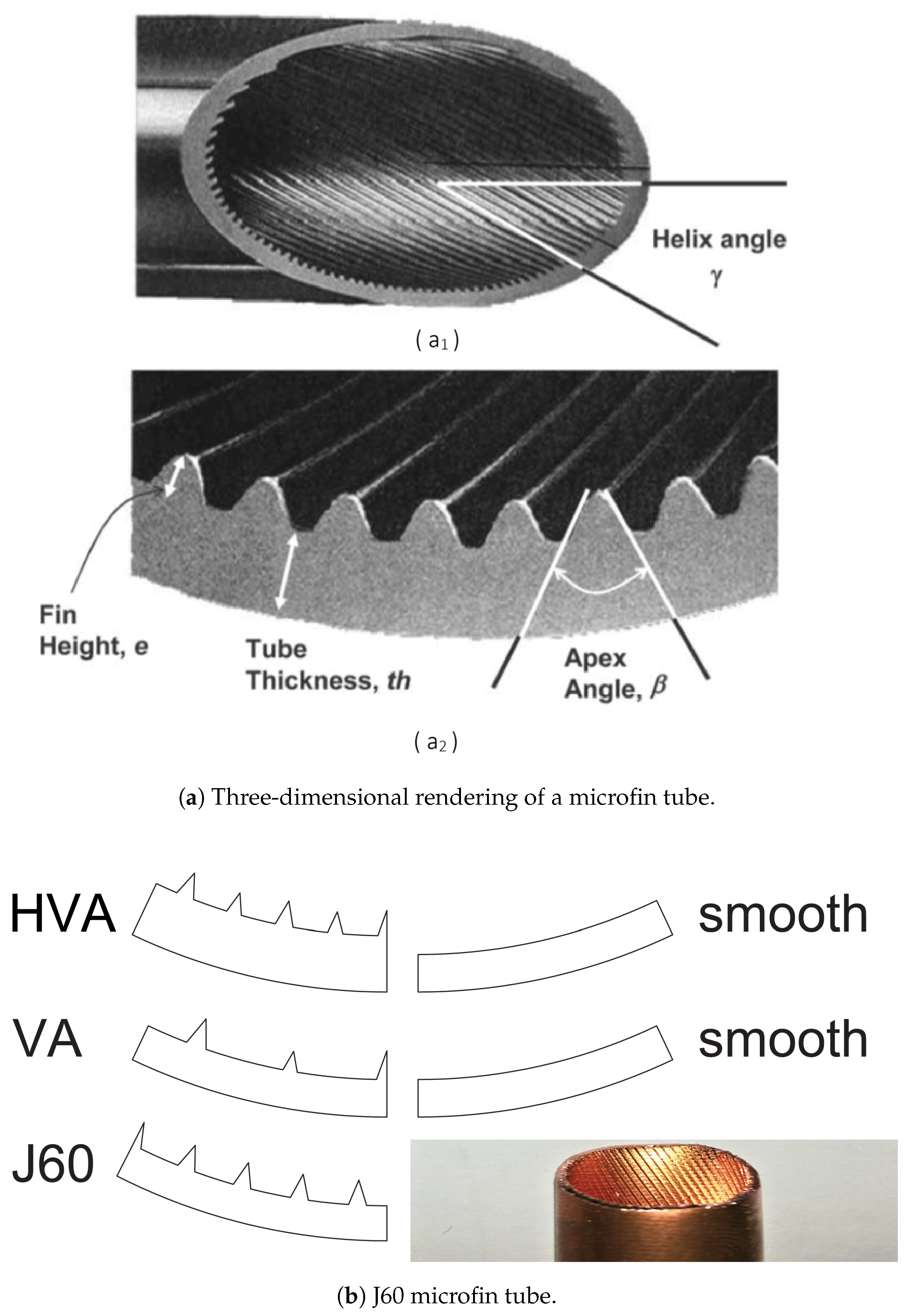
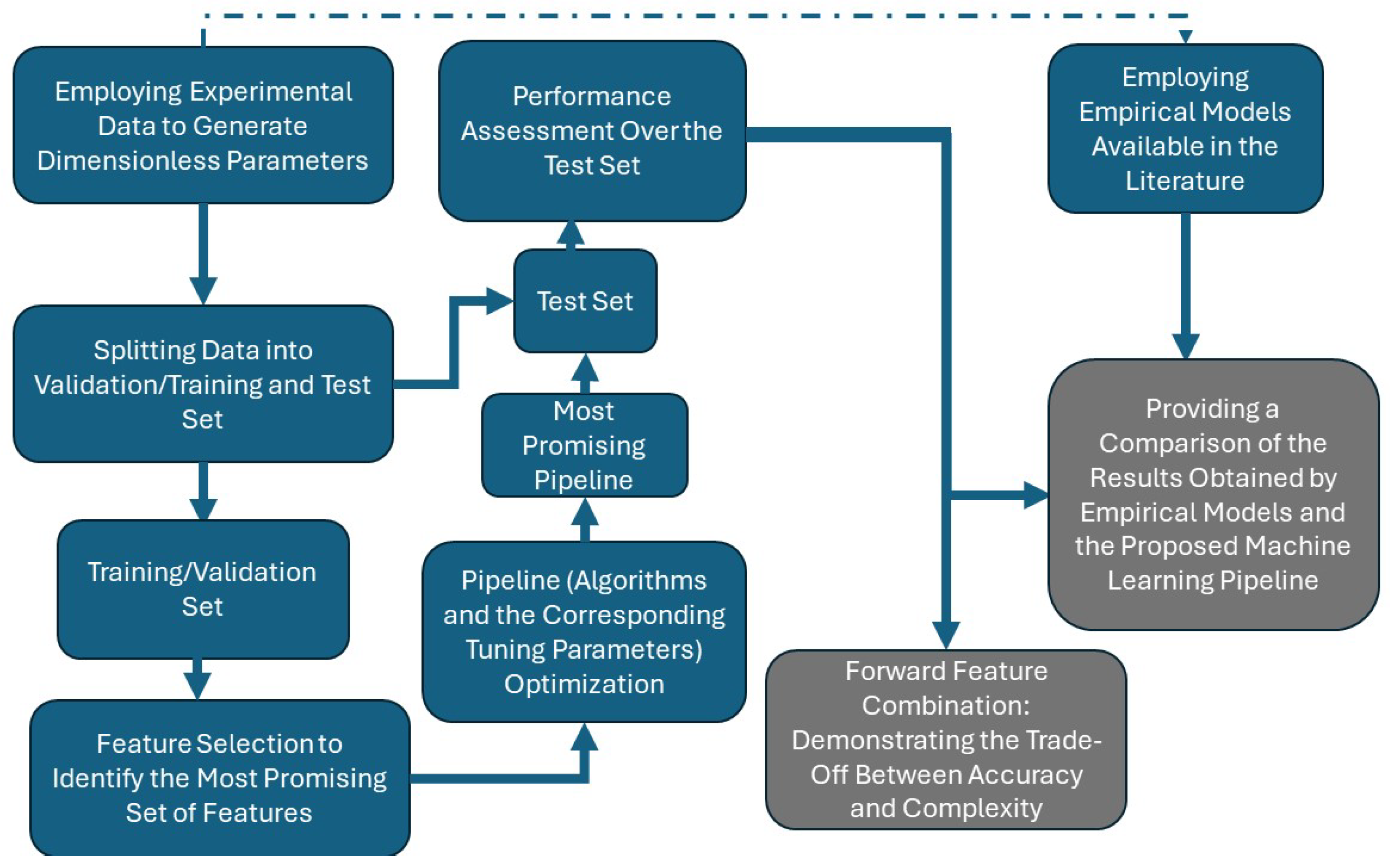


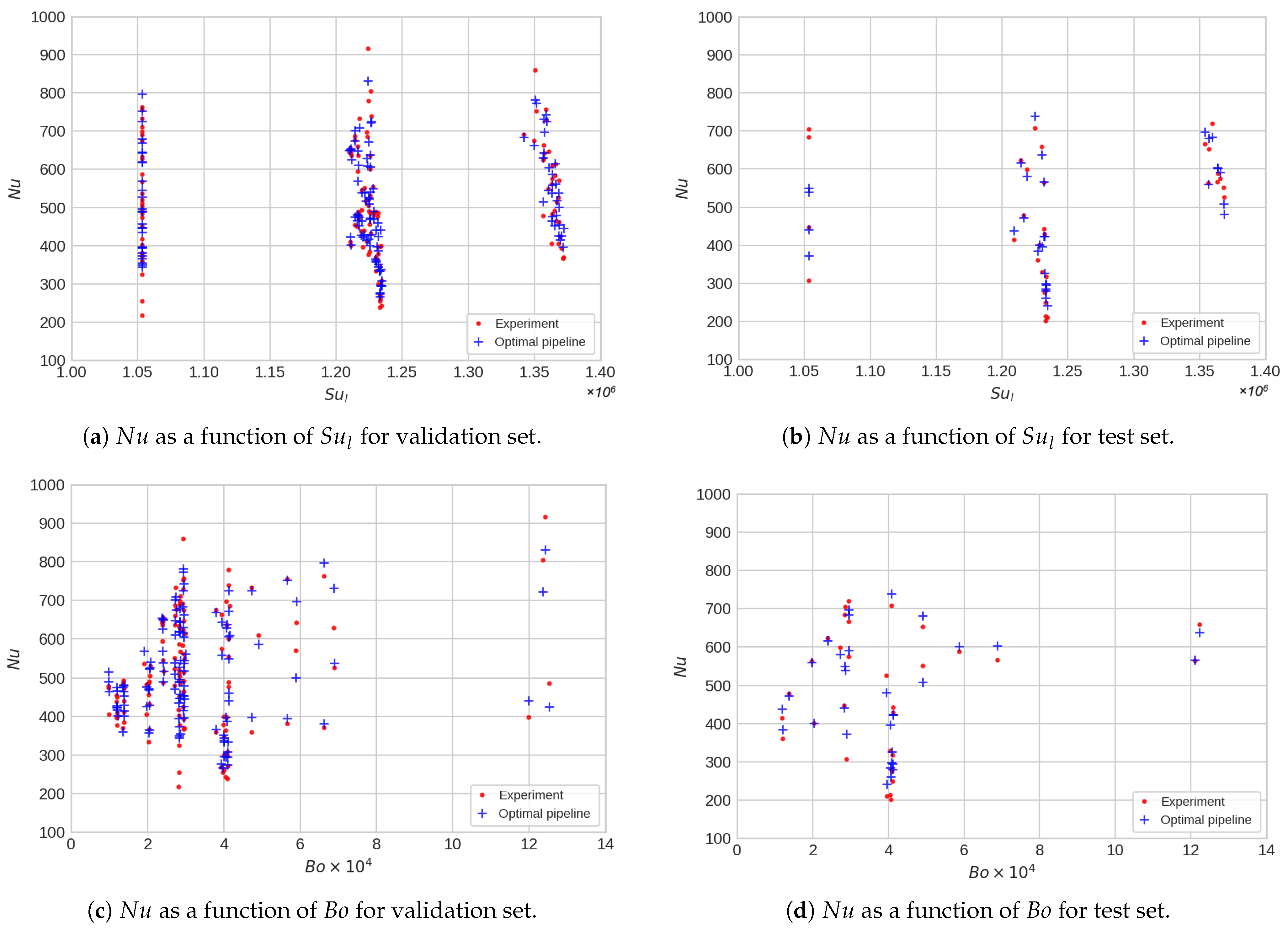

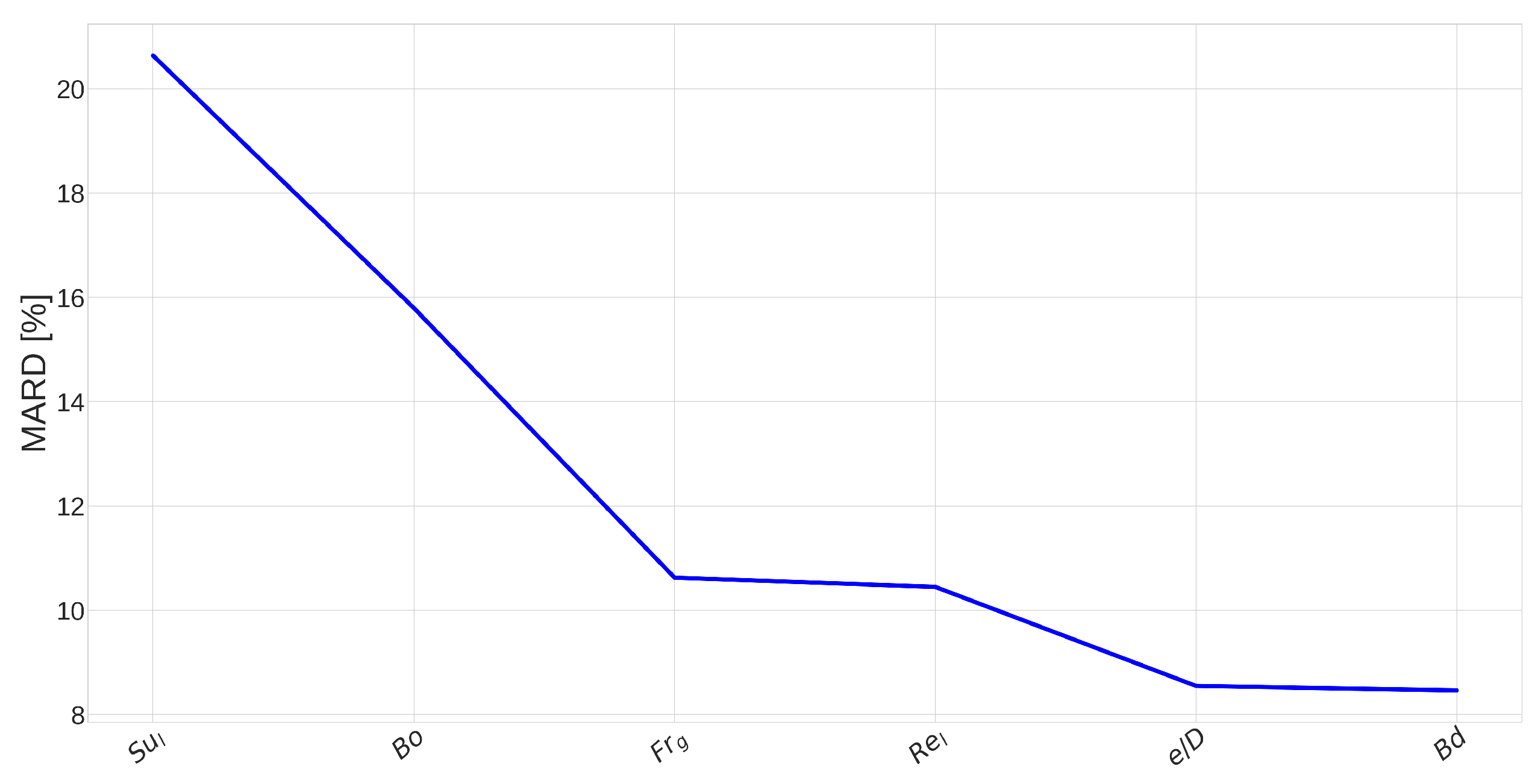
| Parameters | Tubes | Units | ||||
|---|---|---|---|---|---|---|
| Microfin 1 | Microfin 2 | Microfin 3 | ||||
| Name of the tube | J-60 | VA 1 | HVA 1 | [-] | ||
| External diameter | 9.52 | 9.52 | 9.52 | mm | ||
| Internal diameter | 8.96 | 8.92 | 8.62 | mm | ||
| Thickness | 0.28 | 0.3 | 0.45 | mm | ||
| Cross-section area | 62.13 | 61.72 | 57.33 | mm2 | ||
| Wet perimeter | 42.38 | 39.9 | 47.72 | mm | ||
| Rx | 1.68 | 1.6 | 1.88 | [-] | ||
| Fin type | AJ-60 | AVA | BVA | AHVA | BHVA | |
| Fin height | 0.2 | 0.23 | 0.16 | 0.2 | 0.17 | mm |
| Apex angle | 40 | 40 | 40 | 40 | 40 | [○] |
| No. of fins | 60 | 27 | 27 | 41 | 41 | [-] |
| Helix angle | 18 | 18 | 18 | 18 | 18 | [○] |
| Measurement Parameters | Device | Range | Unit | Uncertainty |
|---|---|---|---|---|
| Demineralized water mass flow rate | Coriolis flow meter | 0;400 | 0.15% of the reading | |
| Coriolis flow meter | 0;6500 | 0.3% of the reading | ||
| Refrigerant mass flow rate | Coriolis flow meter | 0;400 | 0.15% of the reading | |
| Water temperature | Thermocouples type K | −180;1350 | [°C] | 0.1 K |
| Refrigerant temperature | Thermocouples type K | −180;1350 | [°C] | 0.1 K |
| Refrigerant inlet pressure | Relative pressure transducer | 0;16 | 0.2% of full scale | |
| Pressure drop | Differential pressure transducer | −15;15 | [psi] | 0.1% of full scale |
| Test section tube length | - | 2000 | mm | 6 mm |
| Voltage of electric heater | - | - | - | 1% of the reading |
| Current of electric heater | - | - | - | 1% of the reading |
| Parameters | Condition | Tubes | Units | ||
|---|---|---|---|---|---|
| J60 | VA | HVA | |||
| Number of data points | Evaporation | 86 | 40 | 33 | [-] |
| Mass fluxes range | 66.3–380.3 | 90–315.6 | 96.7–339.6 | ||
| Mass quality range | 0.15–0.95 | 0.25–0.75 | 0.45–0.8 | [-] | |
| Heat transfer coefficient range | 2023–9204 | 3701–8695 | 2271–7957 | ||
| Empirical Model | MRD [%] | MARD [%] |
|---|---|---|
| Mehendale (2017) [7] | 54.94 | 69.7 |
| Han et al. (2017) [6] | −56.38 | 56.63 |
| Rollmann and Spindler (2016) [5] | 18.51 | 22.42 |
| Chamra and Magro (2006) [4] | −20.98 | 28.24 |
| Yun et al. (2002) [3] | −83.06 | 83.06 |
| Cavallini et al. (1999) [2] | 22.52 | 34.39 |
| Thome et al. (1997) [1] | 80.29 | 80.29 |
| Pipeline | Input Features | Validation Set (CV) | Test Set | ||
|---|---|---|---|---|---|
| MRD [%] | MARD [%] | MRD [%] | MARD [%] | ||
| All features—RF | , , , | 2.05 | 10.42 | 4.64 | 12.54 |
| , , , , , | |||||
| , , , , , | |||||
| , , n, , | |||||
| Selected features—RF | , , , , , | 1.76 | 9.97 | 3.94 | 12.4 |
| Selected features—optimized pipeline | , , , , , | 1.54 | 7.71 | 3.32 | 8.84 |
| Optimal Pipeline | Arguments | Definitions | Values |
|---|---|---|---|
| Step one: ExtraTreesRegressor | bootstrap | Whether the bootstraps are used when building the trees | False |
| max_features | The number of considered features when building the trees | 0.35 | |
| min_samples_leaf | The minimum number of samples at each leaf node | 3 | |
| min_samples_split | The minimum number of samples to split an internal node | 15 | |
| n_estimator | The number of the trees in the forest | 100 | |
| Step two: MaxAbsScaler | - | - | 2 |
| Step three: ElasticNetCV | l1_ratio | The value shows the inclination toward L1 or L2 penalty | 0.1 |
| tol | The tolerance of the optimization | 0.0001 | |
| Step four: RobustScaler | - | - | - |
| Step five: PolynomialFeatures | degree | The degree of the polynomial | 2 |
| include_bias | If True, adding an intercept term to the polynomial | False | |
| interaction_only | If True, only interaction features are produced | False | |
| Step six: RidgeCV | - | - | - |
Disclaimer/Publisher’s Note: The statements, opinions and data contained in all publications are solely those of the individual author(s) and contributor(s) and not of MDPI and/or the editor(s). MDPI and/or the editor(s) disclaim responsibility for any injury to people or property resulting from any ideas, methods, instructions or products referred to in the content. |
© 2024 by the authors. Licensee MDPI, Basel, Switzerland. This article is an open access article distributed under the terms and conditions of the Creative Commons Attribution (CC BY) license (https://creativecommons.org/licenses/by/4.0/).
Share and Cite
Milani, S.; Ardam, K.; Dadras Javan, F.; Najafi, B.; Lucchini, A.; Carraretto, I.M.; Colombo, L.P.M. Heat Transfer Estimation in Flow Boiling of R134a within Microfin Tubes: Development of Explainable Machine Learning-Based Pipelines. Energies 2024, 17, 4074. https://doi.org/10.3390/en17164074
Milani S, Ardam K, Dadras Javan F, Najafi B, Lucchini A, Carraretto IM, Colombo LPM. Heat Transfer Estimation in Flow Boiling of R134a within Microfin Tubes: Development of Explainable Machine Learning-Based Pipelines. Energies. 2024; 17(16):4074. https://doi.org/10.3390/en17164074
Chicago/Turabian StyleMilani, Shayan, Keivan Ardam, Farzad Dadras Javan, Behzad Najafi, Andrea Lucchini, Igor Matteo Carraretto, and Luigi Pietro Maria Colombo. 2024. "Heat Transfer Estimation in Flow Boiling of R134a within Microfin Tubes: Development of Explainable Machine Learning-Based Pipelines" Energies 17, no. 16: 4074. https://doi.org/10.3390/en17164074
APA StyleMilani, S., Ardam, K., Dadras Javan, F., Najafi, B., Lucchini, A., Carraretto, I. M., & Colombo, L. P. M. (2024). Heat Transfer Estimation in Flow Boiling of R134a within Microfin Tubes: Development of Explainable Machine Learning-Based Pipelines. Energies, 17(16), 4074. https://doi.org/10.3390/en17164074







